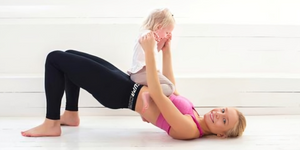Exercising After Giving Birth
Experts recommend waiting approximately 6 weeks after giving birth to return to exercise, however for a Caesarean section, this time may be longer. During pregnancy your abdominal muscles can separate down the middle due to the baby growing, this is called Diastasis of Recti Abdominus Muscle (DRAM). The degree of abdominal separation can vary between women, so it is best to listen to your health care professionals with regard to when to start exercise. It is recommended to gradually reintroduce exercise into your routine after giving birth to allow the body to heal and readjust.
Everyone is different, so exercise programs should be individualized to the person. We recommend talking to a health care practitioner such as a doctor, physiotherapist or exercise physiologist before resuming exercise.
A helpful tip for breast-feeding mothers, exercise after feeding to reduce discomfort of engorged breasts and to reduce milk acidity from lactic acid production which occurs as a by-product of exercise.
Getting back into exercise after giving birth has many benefits both mentally and physically. A study by physical therapists found that after 3 months of completing a yoga and Pilates exercise program, postpartum women experienced reductions in body weight and body fat percentage as well as improvements in depression scores (Yang, Fang, Lee & Pin, 2013). The study found no significant improvements in fatigue, however the improvements in both physical and mental health indicators demonstrated post-partum exercise is very beneficial for mothers.
So, what exercise can post-partum mothers do? After giving birth, it is recommended to start with low intensity and low impact exercise. This could include walking, swimming, yoga or Pilates. Pelvic floor exercises are also recommended as they can help with bladder and bowel control, which can be impacted after pregnancy and giving birth.
Here are some home exercises you could try:
Kegels
Kegels are pelvic floor exercises that involve contracting pelvic floor muscles and relaxing them. To do identify which muscles to contact, think of stopping yourself from urinating midstream. The muscles you contract to do this are your pelvic floor muscles. Find a comfortable position to sit or lay in and practice contracting these muscles, holding it for 5 seconds, then relaxing. Complete 10 repetitions of this 3 times a day.
Draw ins
This exercise is good to engage your deep abdominal muscles. While laying on your back contract your abdominal muscles by pulling your belly button towards your spine. Hold this position for 5 seconds, then relax. Complete 10 repetitions of this 3 times a day.
Pelvic tilt
The exercise is to again activate the pelvic floor muscles. Start by laying on the floor with your feet on the floor and your knees bent to 90 degrees. Think of tipping your hips towards your face and pushing your belly button towards the ground. You shouldn’t be using your legs for this movement, just your hips. Hold this tilted position then return to a resting position and repeat 3 sets of 10 repetitions.
Glute bridge
Glute bridges are good exercises to engage your pelvic floor muscles as well the muscles around your hips. Start with no additional weight and when becomes easy, add weight (3-5kg) across pelvis. Start by laying on your back with your knees bent to 90 degrees. Lift your hips off the ground as high as you can and squeeze your glutes at the top, then lower your hips back to the starting position. Repeat this exercise for 10 reps and 3 sets.

Bird dog exercise
This exercise is good for stability and balance. Start in a crawling position on your hands and knees with your back straight. Extend your right arm out in front of you and your left leg straight behind you. Hold this position for 5 seconds then return to the starting position. Repeat, alternating arms and legs. Complete 3 sets of 10-15 repetitions
Squats
Squats are great exercises that engage many major muscle groups of the body. Start standing with your feet shoulder width apart. Keep your back straight and arms out in front of you. Bend your knees, pushing your weight through the heels of your feet and squat down just like you would to sit in a chair. Return to standing and repeat. Complete 3 sets of repetitions 8 repetitions, add weight when this exercise becomes easy.

How can Supacore help?
Supportive activewear is also important for recovery from pregnancy and support during exercise. The Supacore Coretech compression garments patented waistband technology can assist with lumbopelvic stability by acting as a sacroiliac belt. These garments can be worn postnatal to assist with abdominal recovery from a C section or diastasis recti.
We recommend listening to your body and if you have any concerns, consult your healthcare practitioner.
If you would like more information about DRAM, see our previous blog here.
References
Ko, Y., Yang, C., Fang, C., Lee, M., & Lin, P. (2013). Community based postpartum exercise program. Journal of Clinical Nursing, 22(15), 2122-2131. Doi: 10.1111/jocn.12117
Artal, R & O’Toole, M. (2003). Guidelines of the American college of Obstetricians and Gynaecologists for exercise during pregnancy and the postpartum period. British Journal of Sports Medicine, 37(1), 6-12. Doi: 10.1136/bjsm.37.1.6

